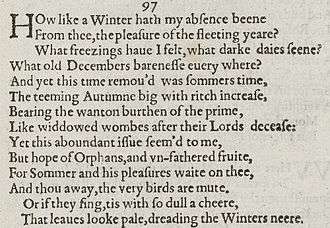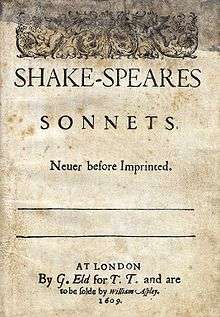Sonnet 97
| Sonnet 97 | |||||||
|---|---|---|---|---|---|---|---|
 Sonnet 97 in the 1609 Quarto | |||||||
|
| |||||||
| |||||||
Sonnet 97 is one of 154 sonnets written by the English playwright and poet William Shakespeare. It is a member of the Fair Youth sequence, in which the poet expresses his love towards a young man. It is the first of three sonnets describing a separation between the speaker and the beloved.
Paraphrase
My separation from you has seemed like winter, since you give pleasure to the year. Winter has seemed to be everywhere, even though in reality our separation occurred during summer and fall, when the earth produces plant life like a widow giving birth after the death of her husband. Yet I saw these fruits of nature as hopeless orphans, since it could not be summer unless you were here; since you were away, even the birds did not sing, or rather sang so plaintively that they made the very leaves look pale, thinking of winter.
Structure
Sonnet 97 is an English or Shakespearean sonnet. The English sonnet has three quatrains, followed by a final rhyming couplet. It follows the typical rhyme scheme of the form abab cdcd efef gg and is composed in iambic pentameter, a type of poetic metre based on five pairs of metrically weak/strong syllabic positions. The 6th line exemplifies a regular iambic pentameter:
× / × / × / × / × / The teeming autumn, big with rich increase, / × × / × / × / × / Bearing the wanton burden of the prime, (97.6-7)
- / = ictus, a metrically strong syllabic position. × = nonictus.
It is followed (in line 7) by an initial reversal, a fairly common metrical variation which also potentially occurs in lines 1, 9, and 13. A mid-line inversion occurs in line 8 and, more plainly, line 14:
× / × / / × × / × / That leaves look pale, dreading the winter's near. (97.14)
Sources and analysis
Following Edmond Malone, T. W. Baldwin notes a resemblance between this poem's trope for the seasons and the "childing autumn" of A Midsummer Night's Dream 2.1.112; he traces the figure to Ovid.
Dowden says that 97 seems to begin a new group of sonnets, comprising 97, 98, and 99. Edward Hubler remarks on the "passages of unobtrusive melody and easy grace."
Thematically, the poem belongs among those poems treating absence or separation. Hilton Landry groups the sonnet with others, such as 54 and 55, in which the speaker is forced to call to mind an inferior mental substitute for his absent beloved.
Notes
- ↑ Pooler, C[harles] Knox, ed. (1918). The Works of Shakespeare: Sonnets. The Arden Shakespeare [1st series]. London: Methuen & Company. OCLC 4770201.
References
- Baldwin, T. W. On the Literary Genetics of Shakespeare's Sonnets. Urbana: University of Illinois Press, 1950.
- Dowden, Edward. Shakespeare's Sonnets. London, 1881.
- Hubler, Edwin. The Sense of Shakespeare's Sonnets. Princeton: Princeton University Press, 1952.
- First edition and facsimile
- Shakespeare, William (1609). Shake-speares Sonnets: Never Before Imprinted. London: Thomas Thorpe.
- Lee, Sidney, ed. (1905). Shakespeares Sonnets: Being a reproduction in facsimile of the first edition. Oxford: Clarendon Press. OCLC 458829162.
- Variorum editions
- Alden, Raymond Macdonald, ed. (1916). The Sonnets of Shakespeare. Boston: Houghton Mifflin Company. OCLC 234756.
- Rollins, Hyder Edward, ed. (1944). A New Variorum Edition of Shakespeare: The Sonnets [2 Volumes]. Philadelphia: J. B. Lippincott & Co. OCLC 6028485.
- Modern critical editions
- Atkins, Carl D., ed. (2007). Shakespeare's Sonnets: With Three Hundred Years of Commentary. Madison: Fairleigh Dickinson University Press. ISBN 978-0-8386-4163-7. OCLC 86090499.
- Booth, Stephen, ed. (2000) [1st ed. 1977]. Shakespeare's Sonnets (Rev. ed.). New Haven: Yale Nota Bene. ISBN 0-300-01959-9. OCLC 2968040.
- Burrow, Colin, ed. (2002). The Complete Sonnets and Poems. The Oxford Shakespeare. Oxford: Oxford University Press. ISBN 978-0192819338. OCLC 48532938.
- Duncan-Jones, Katherine, ed. (2010) [1st ed. 1997]. Shakespeare's Sonnets. The Arden Shakespeare, Third Series (Rev. ed.). London: Bloomsbury. ISBN 978-1-4080-1797-5. OCLC 755065951.
- Evans, G. Blakemore, ed. (1996). The Sonnets. The New Cambridge Shakespeare. Cambridge: Cambridge University Press. ISBN 978-0521294034. OCLC 32272082.
- Kerrigan, John, ed. (1995) [1st ed. 1986]. The Sonnets ; and, A Lover's Complaint. New Penguin Shakespeare (Rev. ed.). Penguin Books. ISBN 0-14-070732-8. OCLC 15018446.
- Mowat, Barbara A.; Werstine, Paul, eds. (2006). Shakespeare's Sonnets & Poems. Folger Shakespeare Library. New York: Washington Square Press. ISBN 978-0743273282. OCLC 64594469.
- Orgel, Stephen, ed. (2001). The Sonnets. The Pelican Shakespeare (Rev. ed.). New York: Penguin Books. ISBN 978-0140714531. OCLC 46683809.
- Vendler, Helen, ed. (1997). The Art of Shakespeare's Sonnets. Cambridge, MA: The Belknap Press of Harvard University Press. ISBN 0-674-63712-7. OCLC 36806589.
.png)
